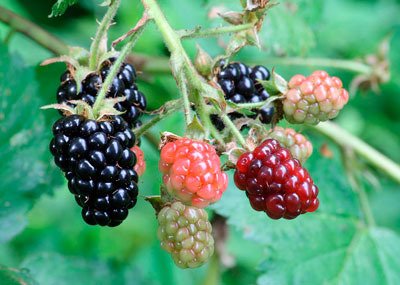Recipe: Halibut with blackberries
Ingredients
2 halibut fillets, about 1 pound total weight
Salt
Pepper
2 Tablespoons olive oil
1 Tablespoon butter
1 shallot, minced
3 Tablespoons raspberry vinegar
1 cup ripe blackberries
Parsley
Season the fillets with salt and pepper. Heat olive oil and butter in a sauté pan over medium high heat. When butter is melted, add fillets and sauté on one side for 5 minutes. Turn and sauté for 5 minutes more. Transfer fillets to a warm plate.
Working quickly, add the minced shallot to the pan and sauté for 2-3 minutes, until it becomes transparent. Add the vinegar and swirl it in the pan. Stir and scrape the sides and bottom of the pan until browned bits dissolve and the sauce is reduced by half. Season with salt and pepper and remove from the heat.
Spoon sauce over fillets, scatter blackberries over top, garnish with parsley and serve immediately.
By Jeanette Stehr-Green
The next four articles will be all about berries: blackberries, blueberries, red raspberries and strawberries! Growing blackberries is as easy as pie! The plants are not as finicky as other berries and suffer from few diseases and pests. They produce well for 15 or more years and once established can provides buckets of delicious berries each season.
Follow these steps for blackberry growing success.
Select blackberry varieties suited for our climate. (See sidebar.) You can choose among three types of blackberries: erect, semi-erect and trailing.
Erect blackberries produce stiff, upright canes with glossy, firm berries with large seeds. Semi-erect blackberries produce thick, arching canes and fruit similar to erect blackberries. They are the heaviest producers of the three types. Trailing blackberries produce lengthy canes that naturally trail along the ground unless trellised; their fruit tends to be sweeter and more aromatic than erect blackberries and have smaller seeds. Trailing blackberries also are more sensitive to cold than the other types.
Blackberries do best in full sun. Almost any soil type will work as long as the drainage is good. A soil pH between 5.5 and 7 (slightly acidic) is ideal.
Plant blackberries (usually available as bare-root plants) in the early spring as soon as the ground can be worked. Dig a large, shallow hole. Spread out the root mass and set the plant so that the uppermost roots are one inch below the soil surface. Refill the hole with native soil and water to remove air pockets.
Space trailing and semi-erect blackberries 5-6 feet apart and erect blackberries 3-4 feet apart. Leave 8 to 10 feet between rows.
To help plants become established, apply a 5-10-10 fertilizer at 2, 6 and 10 weeks after planting and remove any flowers that form the first year. In subsequent years, use plant growth as a guide for fertilizing; apply a greater amount of nitrogen fertilizer if leaves are pale or cane growth is poor.
Apply 3 inches of mulch to maintain soil moisture and limit weeds. Because blackberry roots are superficial, hand weed carefully.
Make sure plants receive 1-2 inches of water each week. Use drip irrigation, if possible, to minimize wetting the fruit and foliage which encourages disease.
Each year, your blackberry plants will put out new canes which live for two years. The first year, the canes grow in height and produce leaves; in the second year, they bear fruit and die.
Prune and trellis your blackberries based on their type. For erect and semi-erect blackberries, tip-prune first-year canes when they are 3-4 feet tall to encourage lateral branching. The following spring, cut back lateral branches on erect blackberries (but not semi-erect blackberries) to about 2 feet. Do not tip-prune trailing blackberries. For all types of blackberries, remove second-year canes after they have fruited.
Train trailing blackberries using a two-wire trellis with wires 4.5 and 6 feet above the ground. In the fall, wrap first-year canes, one or two at a time, around both wires, working away from the plant. Separate canes along the wires to ensure good air circulation.
Although semi-erect and erect blackberries are more self-supporting, a double-T trellis (with two sets of wires running on either side of the plant at about 3 and 5 feet high) will help keep fruit off the ground.
Join us next week to learn about “Growing Blueberries”!
Jeanette Stehr-Green is a Washington State University-certified, Clallam County Master Gardener.



